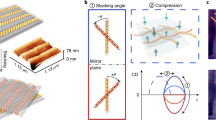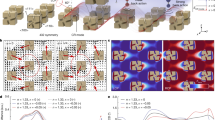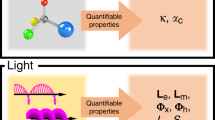Abstract
Circularly polarized light (CPL) exerts a force of different magnitude on left- and right-handed enantiomers, an effect that could be exploited for chiral resolution of chemical compounds1,2,3,4,5 as well as controlled assembly of chiral nanostructures6,7. However, enantioselective optical forces are challenging to control and quantify because their magnitude is extremely small (sub-piconewton) and varies in space with sub-micrometre resolution2. Here, we report a technique to both strengthen and visualize these forces, using a chiral atomic force microscope probe coupled to a plasmonic optical tweezer8,9,10,11,12,13. Illumination of the plasmonic tweezer with CPL exerts a force on the microscope tip that depends on the handedness of the light and the tip. In particular, for a left-handed chiral tip, transverse forces are attractive with left-CPL and repulsive with right-CPL. Additionally, total force differences between opposite-handed specimens exceed 10 pN. The microscope tip can map chiral forces with 2 nm lateral resolution, revealing a distinct spatial distribution of forces for each handedness.
This is a preview of subscription content, access via your institution
Access options
Access Nature and 54 other Nature Portfolio journals
Get Nature+, our best-value online-access subscription
$29.99 / 30 days
cancel any time
Subscribe to this journal
Receive 12 print issues and online access
$259.00 per year
only $21.58 per issue
Buy this article
- Purchase on Springer Link
- Instant access to full article PDF
Prices may be subject to local taxes which are calculated during checkout




Similar content being viewed by others
References
Canaguier-Durand, A., Hutchison, J. A., Genet, C. & Ebbesen, T. W. Mechanical separation of chiral dipoles by chiral light. New J. Phys. 15, 123037 (2013).
Hayat, A., Mueller, J. P. B. & Capasso, F. Lateral chirality-sorting optical forces. Proc. Natl Acad. Sci. USA. 112, 13190–13194 (2015).
Tkachenko, G. & Brasselet, E. Optofluidic sorting of material chirality by chiral light. Nat. Commun. 5, 3577 (2014).
Wang, S. B. & Chan, C. T. Lateral optical force on chiral particles near a surface. Nat. Commun. 5, 4307 (2014).
Robert, P. C., Stephen, M. B. & Alison, M. Y. Discriminatory optical force for chiral molecules. New J. Phys. 16, 013020 (2014).
Noorduin, W. L. et al. Complete chiral symmetry breaking of an amino acid derivative directed by circularly polarized light. Nat. Chem. 1, 729–732 (2009).
Yeom, J. et al. Chiral templating of self-assembling nanostructures by circularly polarized light. Nat. Mater. 14, 66–72 (2015).
Berthelot, J. et al. Three-dimensional manipulation with scanning near-field optical nanotweezers. Nat. Nanotech. 9, 295–299 (2014).
Grigorenko, A. N., Roberts, N. W., Dickinson, M. R. & Zhang, Y. Nanometric optical tweezers based on nanostructured substrates. Nat. Photon. 2, 365–370 (2008).
Ndukaife, J. C. et al. Long-range and rapid transport of individual nano-objects by a hybrid electrothermoplasmonic nanotweezer. Nat. Nanotech. 11, 53–59 (2016).
Righini, M., Volpe, G., Girard, C., Petrov, D. & Quidant, R. Surface plasmon optical tweezers: tunable optical manipulation in the femtonewton range. Phys. Rev. Lett. 100, 186804 (2008).
Roxworthy, B. J., Bhuiya, A. M., Vanka, S. P. & Toussaint, K. C. Understanding and controlling plasmon-induced convection. Nat. Commun. 5, 3173 (2014).
Shoji, T. & Tsuboi, Y. Plasmonic optical tweezers toward molecular manipulation: tailoring plasmonic nanostructure, light source, and resonant trapping. J. Phys. Chem. Lett. 5, 2957–2967 (2014).
Bailey, J. et al. Circular polarization in star-formation regions: implications for biomolecular homochirality. Science 281, 672–674 (1998).
Cronin, J. R. & Pizzarello, S. Enantiomeric excesses in meteoritic amino acids. Science 275, 951–955 (1997).
Kuzyk, A. et al. Reconfigurable 3D plasmonic metamolecules. Nat. Mater. 13, 862–866 (2014).
Alizadeh, M. H. & Reinhard, B. M. Transverse chiral optical forces by chiral surface plasmon polaritons. ACS Photon. 2, 1780–1788 (2015).
Tang, Y. & Cohen, A. E. Enhanced enantioselectivity in excitation of chiral molecules by superchiral light. Science 332, 333–336 (2011).
Lu, F., Jin, M. & Belkin, M. A. Tip-enhanced infrared nanospectroscopy via molecular expansion force detection. Nat. Photon. 8, 307–312 (2014).
Munday, J. N., Capasso, F. & Parsegian, V. A. Measured long-range repulsive Casimir–Lifshitz forces. Nature 457, 170–173 (2009).
de Man, S., Heeck, K. & Iannuzzi, D. Halving the Casimir force with conductive oxides: experimental details. Phys. Rev. A 82, 062512 (2010).
Rajapakse, I., Uenal, K. & Wickramasinghe, H. K. Image force microscopy of molecular resonance: a microscope principle. Appl. Phys. Lett. 97, 073121 (2010).
Huang, F., Tamma, V. A., Mardy, Z., Burdett, J. & Wickramasinghe, H. K. Imaging nanoscale electromagnetic near-field distributions using optical forces. Sci. Rep. 5, 10610 (2015).
Nowak, D. et al. Nanoscale chemical imaging by photoinduced force microscopy. Sci. Adv. 2, e1501571 (2016).
Saleh, A. A. E., Sheikhoelislami, S., Gastelum, S. & Dionne, J. A. Grating-flanked plasmonic coaxial apertures for efficient fiber optical tweezers. Opt. Express 24, 20593–20603 (2016).
Van de Haar, M. A., Maas, R., Schokker, H. & Polman, A. Experimental realization of a polarization-independent ultraviolet/visible coaxial plasmonic metamaterial. Nano Lett. 14, 6356–6360 (2014).
Zhao, Y., Saleh, A. A. E. & Dionne, J. A. Enantioselective optical trapping of chiral nanoparticles with plasmonic tweezers. ACS Photon. 3, 304–309 (2016).
Lezec, H. J. et al. Beaming light from a subwavelength aperture. Science 297, 820–822 (2002).
Hentschel, M., Schäferling, M., Weiss, T., Liu, N. & Giessen, H. Three-dimensional chiral plasmonic oligomers. Nano Lett. 12, 2542–2547 (2012).
Bekshaev, A. Y. Subwavelength particles in an inhomogeneous light field: optical forces associated with the spin and orbital energy flows. J. Opt. 15, 044004 (2013).
Acknowledgements
The authors thank A. Polman from the Stichting voor Fundamenteel Onderzoek der Materie (FOM) Institute AMOLF for discussions. The authors acknowledge funding from the Gordon and Betty Moore Foundation, a National Science Foundation CAREER Award (DMR- 1151231), a Presidential Early Career Award administered through the Air Force Office of Scientific Research (FA9550-15-1-0006) and the European Research Council. This work is part of the research programme of FOM, which is part of the Nederlandse Organisatie voor Wetenschappelijk Onderzoek.
Author information
Authors and Affiliations
Contributions
Y.Z. and J.A.D. conceived and designed the experiments. Y.Z., A.A.E.S. and M.A.v.d.H. performed the experiments. A.L. and O.A.R.-B. assisted with the experiments. Y.Z. and B.B. conducted the theory and numerical simulations. Y.Z., J.A.B. and J.A.D. co-wrote the paper. J.A.D. supervised the entire study. All authors contributed to the analysis of the data and revision of the paper.
Corresponding authors
Ethics declarations
Competing interests
The authors declare no competing financial interests.
Supplementary information
Supplementary information
Supplementary information (PDF 1400 kb)
Rights and permissions
About this article
Cite this article
Zhao, Y., Saleh, A., van de Haar, M. et al. Nanoscopic control and quantification of enantioselective optical forces. Nature Nanotech 12, 1055–1059 (2017). https://doi.org/10.1038/nnano.2017.180
Received:
Accepted:
Published:
Issue Date:
DOI: https://doi.org/10.1038/nnano.2017.180
This article is cited by
-
A 2D chiral microcavity based on apparent circular dichroism
Nature Communications (2024)
-
Visualizing ultrafast photothermal dynamics with decoupled optical force nanoscopy
Nature Communications (2023)
-
Self-assembled inorganic chiral superstructures
Nature Reviews Chemistry (2022)
-
Exploiting rotational asymmetry for sub-50 nm mechanical nanocalligraphy
Microsystems & Nanoengineering (2021)
-
Highly enantioselective photo-polymerization enhanced by chiral nanoparticles and in situ photopatterning of chirality
Nature Communications (2020)



